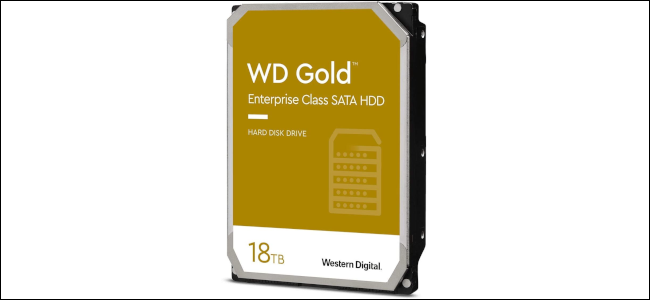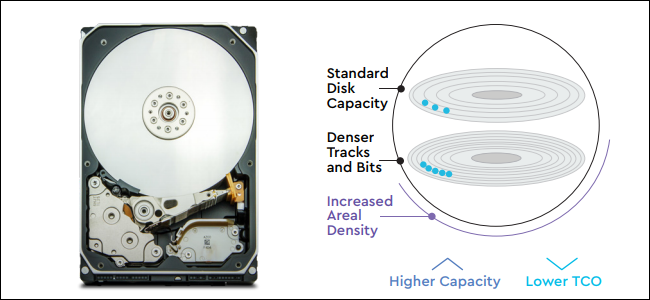Quick Links
Hard drives are like printers: the technology is so old and well-understood, there’s really nothing new happening. Besides, aren't we all about NVMe and SATA SSDs these days?
Mechanical Hard Drives Are Still Big Business
While it's true consumers have largely moved on, data centers are still looking for higher capacity hard drives. That’s why Western Digital (WD) developed new enterprise drives, which are packing what the company calls "ePMR" (energy-assisted perpendicular magnetic recording). For simplicity's sake, we'll stick with energy-assisted magnetic recording (EAMR).
In July 2020, Western Digital announced its new drives, including 16 and 18 TB Gold Enterprise drives, and an Ultrastar EAMR drive with a whopping 20 TB coming soon.
That's some massive storage, and that much capacity in a single drive enticing. Unfortunately, you won’t be able to pack one of these 3.5-inch monsters in your tower anytime soon. For now, this is all about the enterprise.
Still, for the budding PC tech enthusiast, this technology is worth keeping an eye on.
What Hard Drive Manufacturers Are Chasing
Every computer component has something upon which engineers want to improve. When it comes to processors, they generally want to shrink the size and boost clock speeds. For hard drives, though, the focus is on packing more bits onto the same platter size.
Shutterstock Username/link missing.
Hard drives are comprised of a number of components, but the two primaries are the discs (or platters) that contain the data, and the head that reads and writes the data.
As you might expect, hard drives save data using a binary configuration. The write head travels over the spinning platter and uses a magnetic field to write data in a pattern that corresponds to zeroes and ones.
People often compare a hard drive to a vinyl record player. The record contains audio and the needle goes over a specific point to retrieve it. On an LP, you can actually count the grooves on the vinyl to drop the needle on the right track. The data on a hard drive is so small, you can’t manually move the head to a certain spot, so you have to rely on the computer to do it.
Unlike LPs, however, the head doesn’t just read data, it also writes it. The problem is that write operations on non-EAMR drives aren’t as precise. This means the bits can't be packed as tightly together.
EAMR aims to solve this by making it possible to write bits to a platter in much closer proximity. The WD drives apply an electrical current to the main pole of the write head during operation. This creates an extra magnetic field, which helps create a more consistent write signal. This also means data can be written to the drive more precisely.
When data hits the drive more precisely, it’s possible to pack more bits per inch (BPI) onto the same surface. This is why EAMR is such an advance for hard drives: more precise write operations mean more data can be written on the platter, increasing its areal density.
EAMR isn’t an advance on its own, however; it’s just one of several features that work together to help increase a hard drive’s capacity. Another big advance on the new WD Gold drives is the triple-state actuator (TSA). This mechanical solution more precisely positions the head over the platter. Again, more precise write operations help increase the storage capacity on a platter of the same size.
Over the years, drive manufacturers have made other advances to increase capacity. At one point, they were making thinner platters to stuff more discs into the same-size drive.
When that went about as far as it could, companies like WD took it up a notch by making helium-filled enclosures for the platters. This reduced the internal friction and heat production, making the drive more energy-efficient.
All of this meant you could put more platters in a drive. WD has improved this process, as well, from seven platters in 2013 to the nine it uses today.
While it's an important advance, EAMR works in conjunction with other technologies to achieve higher-capacity drives.
Enterprise Only (for Now)
While hard drives with massive capacities are an enticing prospect for home computers, they’re out of reach at the moment. This could change in a few years, though. Helium-filled drives were also an enterprise-only feature at first, but they came to consumer-grade gear about three years later. You can find them today in drives with capacities of 12 TB or higher, like some of WD's external hard drives.
We asked WD about the prospect of seeing EAMR and TSA in consumer-grade hard drives one day and received the following response:
"While we don’t share future roadmap plans, we are always evaluating customer needs regarding capacity and we recognize that data storage requirements are increasing across many market segments, including consumers."
Without getting into NAS drives, desktops already have pretty good capacities in their hard drives. Just a few years ago, 1 or 2 TB drives were a big deal; now, you can get 6 or 8 TB drives for home PCs. Combine that with multiple NVMe drives and SSDs, and you can pack quite a bit of storage in a single tower.
Still, the notion of 16 TB or more on a single drive is an attractive idea. It seems that in spite of the incredible performance of NVMe and SATA SSDs, the future of hard drives still has some life left in it.




